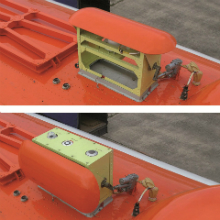Ground-based stations require high spatial density and wide distribution over the territory. For such an enormous territory as Russia it is nearly impossible to have stations all over the country, especially as large parts of the country are not easily accessible. Satellite measurements on the other hand, are not always available in the right place and at the right moment and provide a limited set of data. Roshydromet decided to use another approach - a flying laboratory.
The Russian Federal Service for Hydrometeorology and Environmental Monitoring (Roshydromet), together with the Central Aerological Observatory in Moscow, and the Main Geophysical Observatory in Saint Petersburg, developed a special instrumented airborne platform (an aircraft laboratory) which will become an effective instrument for environmental research. The new airborne laboratory is named ‘Atmosphere’ and will perform simultaneous measurements of various parameters of the atmosphere and the Earth’s surface with high spatial and temporal resolution in a given region - even in the most remote and difficult to access areas.
The laboratory will also allow the integration of groundbased and remote sensing data in one informational picture. As an extension to its functions the aircraft will also be used for cloud modification and control by means of cloud seeding. The YAK-42D aircraft was specially modified by Myasishchev Design Bureau of Zhukovsky, Moscow Region to satisfy the research needs of Roshydromet and to carry all the necessary equipment.
The aircraft carries a set of equipment that measures gaseous and aerosol composition of the atmosphere. The data enables the identification at an early stage of various climate factors that may lead to changes on regional and global scales. Both natural fluctuations and anthropogenic influences in aerosol composition, concentration of ozone, greenhouse gases, nitrogen oxides and other gases can be detected by the system consisting of lidar, gas analysers, spectrometers and chemiluminescent instruments.
The flying laboratory will be monitoring radioactive contamination of the air and the underlying surface by measuring gamma radiation dose rate and isotopic composition. The measurements made by such an airborne laboratory will allow not only the determination of the amount of pollution but also the identification of possible sources of pollution and directions in which that pollution may spread.
A special radar tracking system is used for research into clouds and precipitation and creating maps of different weather phenomena. Also the aircraft has on board systems for measuring cloud microphysical parameters and cloud modification equipment.
A set of probes is used to measure electrical characteristics of the atmosphere, such as the potential of the ionosphere and its changes, and electrical charges in the troposphere associated with aerosol layers and clouds. Electrically charged cloud layers often represent a hazard for aeroplanes and the range of instruments onboard the flying laboratory will allow the study of these clouds with great detail.
Instruments installed in special booms under the wings of the aircraft measure thermodynamic parameters of the atmosphere such as temperature, pressure, wind speed, humidity and atmospheric turbulences, which are necessary for analysing data from other measurement systems.
Radiative balance and remote sensing of clouds and the underlying surface is measured with a system that includes Kipp & Zonen radiometers. Instruments for measurements of solar, sky and terrestrial radiation were supplied via our Russian distributor RPO ATTEX. Two CMP 22 pyranometers and two CGR 4 pyrgeometers were installed on the top and the bottom of the aircraft to measure downward and upward short-wave and long wave radiation. A UVS-B-T was installed on top of the aircraft to measure the downward UVB radiation.
 The instruments were mounted in a rack integrated into a specially designed fairing structure with a retractable cover to protect the instruments when no measurements are taken.
The instruments were mounted in a rack integrated into a specially designed fairing structure with a retractable cover to protect the instruments when no measurements are taken.
Measuring the net short-wave fluxes at the aircraft and at the surface allows determination of the absorption of solar radiation by the atmospheric layers below and above the aircraft. By measuring the long-wave thermal radiation at the same time the scientists can evaluate the influences of natural and anthropogenic aerosols and greenhouse gases on the radiative balance.
The data from high precision Kipp & Zonen radiometers are combined with high resolution spectral and brightness temperature measurements made by the scientific equipment developed in Russia by NPO Lepton of Zelenograd, Moscow Region, and the Main Geophysical Observatory.
In the summer of 2013 the new flying laboratory of Roshydromet undertook a series of test flights to test the aircraft and the instruments in various conditions; maximum and minimum height, speed and acceleration, tilts, etc. From November the laboratory started its routine monitoring flights.
You can find more information about the ‘Atmosphere’ airborne laboratory and other projects on the websites of Roshydromet at www.meteorf.ru and the Central Aerological Observatory www.cao-rhms.ru .
Our distributor for Russia, RPO ATTEX, can be found at www.attex.net.